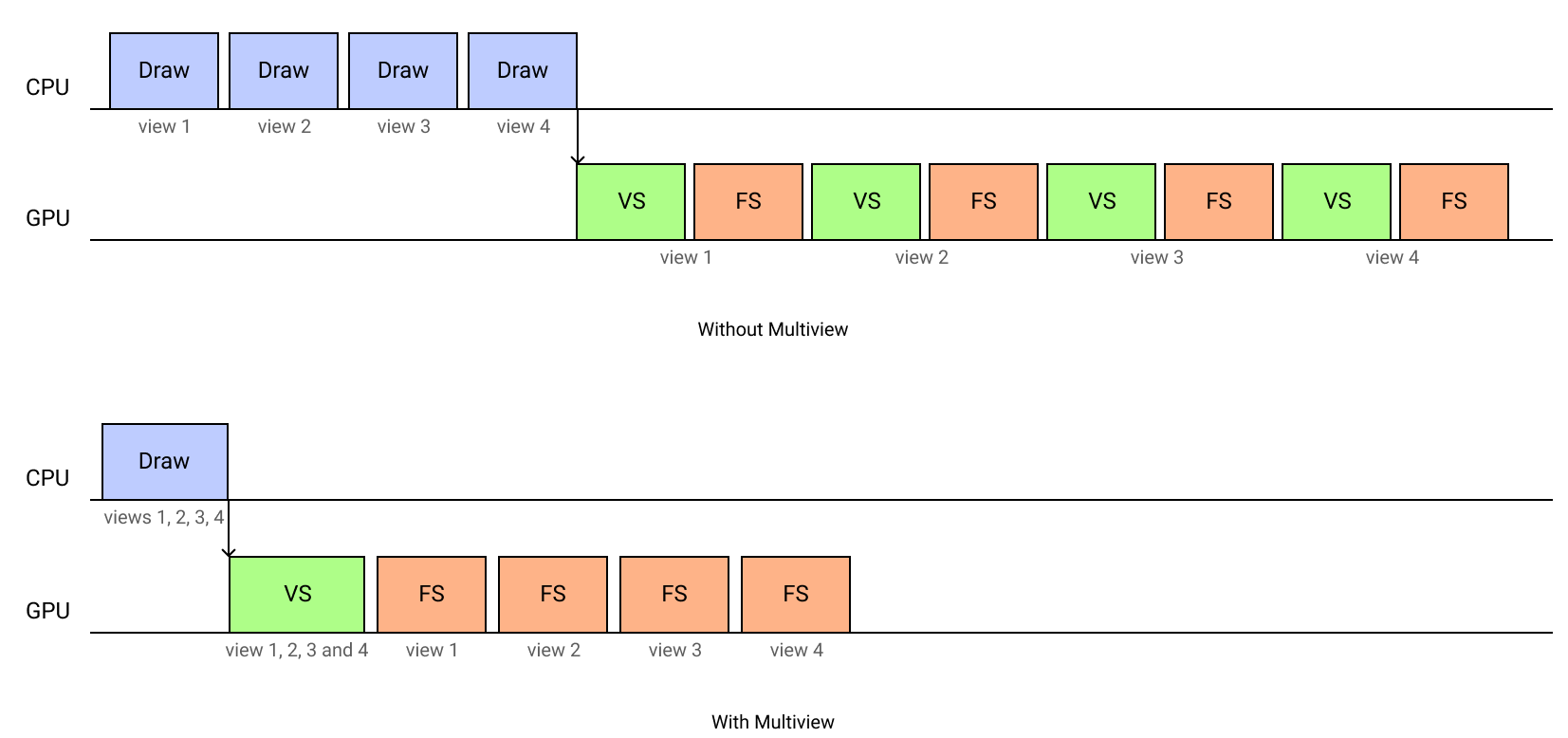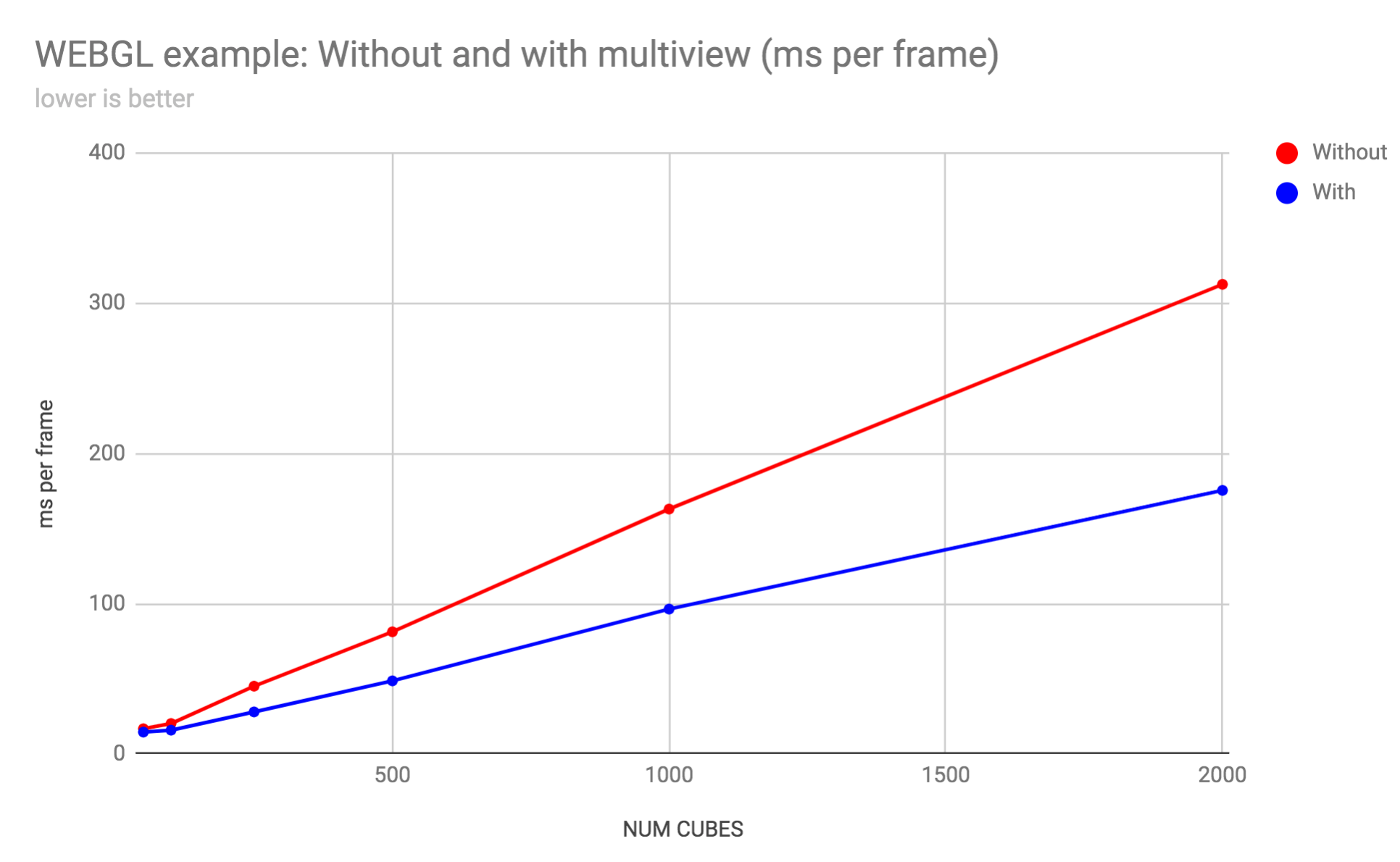The WebGL multiview extension is already available in several browsers and 3D web engines, and it could easily help to improve the performance of your WebXR application.
What is multiview?
When VR first arrived, many engines supported stereo rendering by running all the render stages twice, one for each camera/eye. While it works, it is highly inefficient.
for (eye in eyes)
renderScene(eye)Where renderScene will set up the viewport, shaders, and states every time it is called. This will double the cost of rendering every frame.
Later on, some optimizations started to appear in order to improve the performance and minimize the state changes.
for (object in scene)
for (eye in eyes)
renderObject(object, eye)Even if we reduce the number of state changes, by switching programs and grouping objects, the number of draw calls remains the same: two times the number of objects.
In order to minimize this bottleneck, the multiview extension was created. The TL;DR of this extension is: Using just one draw call, you can draw on multiple targets, reducing the overhead per view.

This is done by modifying your shader uniforms with the information for each view and accessing them with the gl_ViewID_OVR, similar to how the Instancing API works.
in vec4 inPos;
uniform mat4 u_viewMatrices[2];
void main() {
gl_Position = u_viewMatrices[gl_ViewID_OVR] * inPos;
}The resulting render loop with the multiview extension will look like:
for (object in scene)
setUniformsForBothEyes() // Left/Right camera matrices
renderObject(object)This extension can be used to improve multiple tasks, such as cascaded shadow maps, rendering cubemaps, and rendering multiple viewports in CAD software, although the most common use case is stereo rendering.
Stereo rendering is also our main target, as this will improve the VR rendering path performance with just a few modifications in a 3D engine. Currently, most headsets have two views, but there are prototypes of headsets with an ultra-wide FOV using four views, which is currently the maximum number of views supported by multiview.
Multiview in WebGL
Once the OpenGL OVR_multiview2 specification was created, the WebGL working group started to make a WebGL version of this API.
It’s been a while since our first experiment supporting multiview on servo and three.js. Back then, it was quite a challenge to support WEBGL_multiview: it was based on opaque framebuffers, and it was possible to use it with WebGL1, but the shaders needed to be compiled with GLSL 3.0 support, which was only available on WebGL2, so some hacks on the Servo side were needed to get it running.
At that time the WebVR spec had a proposal to support multiview but it was not approved.
Thanks to the work of the WebGL WG, the multiview situation has improved a lot in the last few months. The specification is already in 'Community Approved' status, which means that browsers can ship it enabled by default (as we do on Firefox desktop 70 and Firefox Reality 1.4).
Some important restrictions of the final specification to note:
- It only supports
WebGL2contexts, as it needsGLSL 3.00andtexture arrays. - Currently, there is no way to use multiview to render to a multisampled backbuffer, so you should create contexts with
antialias: false. (The WebGL WG is working on a solution for this).
Web engines with multiview support
We have been working for a while on adding multiview support to three.js (PR). Currently, it is possible to get the benefits of multiview automatically as long as the extension is available and you define a WebGL2 context without antialiasing:
var context = canvas.getContext( 'webgl2', { antialias: false } );
renderer = new THREE.WebGLRenderer( { canvas: canvas, context: context } );You can see a three.js example using multiview here (source code).
A-Frame is based on three.js, so it should get multiview support as soon as it is updated to the latest release.
Babylon.js has had support for OVR_multiview2 already for a while (more info).
For details on how to use multiview directly without using any third-party engine, you can take a look at the three.js implementation, see the specification’s sample code, or read this tutorial by Oculus.
Browsers with multiview support
The extension was just recently approved by the community, so we expect to see all the major browsers adding support for it by default soon.
- Firefox Desktop: Firefox 71 will support multiview enabled by default. In the meantime, you can test it on Firefox Nightly by enabling draft extensions.
- Firefox Reality: It’s already enabled by default since version 1.3.
- Oculus Browser: It’s implemented but disabled by default; you must enable the
Draft WebGL Extensionpreference to use it. - Chrome: You can use it on Chrome Canary for Windows by running it with the following command line parameters:
--use-cmd-decoder=passthrough --enable-webgl-draft-extensions
Performance improvements
Most WebGL or WebXR applications are CPU-bound; the more objects you have on the scene, the more draw calls you will submit to the GPU. In our benchmarks for stereo rendering with two views, we got a consistent improvement of ~40% compared to traditional rendering.
As you can see in the following chart, the more cubes (draw calls) you have to render, the better the performance will be.

What’s next?
The main drawback when using the current multiview extension is that there is no way to render to a multisampling backbuffer. To use it with WebXR, you should set antialias: false when creating the context. However, this is something the WebGL WG is working on.
As soon as they come up with a proposal and it is implemented by the browsers, 3D engines should support it automatically. Hopefully, we will see new extensions arriving in the WebGL and WebXR ecosystem to improve the performance and quality of rendering, such as those exposed by Nvidia VRWorks (e.g., Variable Rate Shading and Lens Matched Shading).
References
- https://developer.nvidia.com/vrworks/graphics/multiview
- https://developer.oculus.com/documentation/mobilesdk/latest/concepts/mobile-multiview/
- https://www.khronos.org/registry/OpenGL/extensions/OVR/OVR_multiview2.txt
- https://community.arm.com/developer/tools-software/graphics/b/blog/posts/optimizing-virtual-reality-understanding-multiview
- https://arm-software.github.io/opengl-es-sdk-for-android/multiview.html
- https://github.com/KhronosGroup/WebGL/issues/2912
- https://developer.oculus.com/documentation/oculus-browser/latest/concepts/browser-multiview/
* Header image by Nvidia VRWorks
